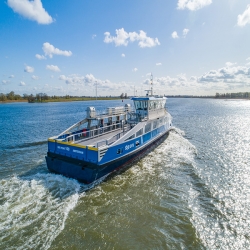Some of the New Products on Show
Inverter expertise and semiconductor protection
Danfoss
 Danfoss will be in Amsterdam to display its solutions for quiet, emission-free, energy-saving shipping, offering customers the ability to charge quickly in port while having full power capacity and generating zero emissions. The company’s systems are already installed on electric ferries such as Noordzeekanaal (NZK) from GVB in the Netherlands, Fanølinjen’s Grotte in Denmark and Wasaline’s Aurora Botnia in Finland.
Danfoss will be in Amsterdam to display its solutions for quiet, emission-free, energy-saving shipping, offering customers the ability to charge quickly in port while having full power capacity and generating zero emissions. The company’s systems are already installed on electric ferries such as Noordzeekanaal (NZK) from GVB in the Netherlands, Fanølinjen’s Grotte in Denmark and Wasaline’s Aurora Botnia in Finland.
For these electric ferries, and for e-tugs like Damen’s RSD-E Tug 2513 (Sparky), Danfoss Drives provides various types of inverters, each based on the same inverter. The software ensures that the inverter (a frequency converter with a DC voltage as input voltage) converts the varying DC voltage from batteries or fuel cells into a higher DC voltage for clients, or vice versa to reduce the DC voltage to charge the batteries.
“We call this a DC-DC converter,” explains Dick Kant, business development manager at Danfoss Drives. “We can also produce an alternating current from this direct current. We can then use a motor inverter to regulate the speed of the alternating-current electric motor, using frequency control. Or we can convert the direct current into alternating current for hotel operation, i.e. from DC to AC, a so-called microgrid. This immediately results in cost savings: you don’t necessarily need shore power. You get the energy from the batteries. The microgrid then behaves like a generator.”
The inverters also make a difference the other way round: they convert the alternating current from the generator into direct current for the central DC electricity network (DC bus system). As a result, the generators function in the same way as a battery pack.
Many battery-powered new-build vessels also have generators on board, to soak up energy or as a backup in case of battery failure. VACON NXP DCGuard is a semiconductor protection device that maintains the stability of the DC grid by rapidly detecting and cutting off any faulty DC currents. It isolates the faulty part of the system within five microseconds, protecting the surrounding equipment and ensuring uninterrupted operation.
Want to talk more about electrification? Join Danfoss on Booth 1166.
